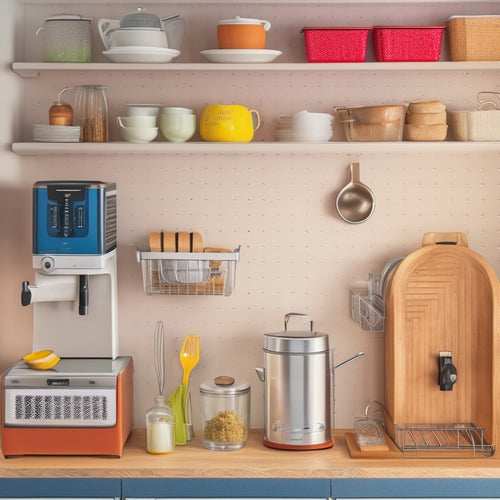
7 Clever Ways to Boost Attic Storage Capacity
Share
You can increase your attic's storage capacity by utilizing vertical space efficiently with shelves, hooks, and storage units. Install adjustable shelving units to customize storage for items of varying sizes. Optimize rafters for storage by reinforcing them and adding hooks, bins, or shelves. Invest in stackable containers to keep items organized and categorized. Create a catwalk for access by clearing floor space and installing supporting beams. Add insulated storage bins to maintain a consistent attic temperature. Designate zones for storage to keep similar items together. By implementing these strategies, you'll be well on your way to opening your attic's full storage potential - and there's more to discover.
Key Takeaways
• Utilize vertical space efficiently by installing shelves, hooks, or storage units to maximize storage capacity in the attic.
• Install adjustable shelving units to customize shelf heights and configurations for optimal space utilization and reconfigure for items of varying sizes.
• Optimize rafters for storage by repurposing them as additional storage areas with proper reinforcement and installing hooks, bins, or shelves.
• Invest in stackable containers to maximize storage capacity, categorize items, label containers, and utilize corner stackers for stability.
• Create a functional zoning system by dividing the attic into zones, implementing labeling and color coding for organization, and designating specific storage areas.
Utilize Vertical Space Efficiently
By installing shelves, hooks, or storage units that maximize your attic's vertical space, you can greatly enhance its storage capacity. This approach allows you to make the most of your attic's often-wasted vertical space.
Think about wall-mounted hooks, which are perfect for hanging items like bikes, luggage, or even seasonal decorations. You can also use hanging baskets to store smaller items like linens, out-of-season clothing, or accessories.
For larger items, overhead racks can be a great solution. These can be used to store boxes, bins, or even luggage. Additionally, floating shelves can provide additional storage for items like books, decorative items, or storage containers.
When choosing your storage solutions, be sure to assess the weight capacity and durability of the materials. It's also essential to ensure that your storage units are securely fastened to the attic walls or ceiling to prevent accidents.
Install Adjustable Shelving Units
You can further optimize your attic's storage capacity by installing adjustable shelving units that allow you to customize the shelf heights and configurations to fit your specific storage needs.
This shelving organization system enables you to make the most of your attic's space utilization, ensuring that every inch is used efficiently.
With adjustable shelving, you can easily reconfigure the shelves to accommodate items of varying sizes, from small boxes to large luggage. This flexibility is especially useful when storing seasonal items, such as winter clothing or holiday decorations, which can be easily accessed and stored away when not in use.
By installing adjustable shelving units, you can significantly increase your attic's storage capacity, keeping your belongings organized and easily accessible.
Additionally, this shelving system helps to keep the attic floor clear, reducing clutter and making it easier to navigate the space.
Optimize Rafters for Storage
After maximizing your attic's floor space with adjustable shelving units, turn your attention to the rafters, which can be repurposed as additional storage areas. This is where you can get creative with your attic organization. To optimize your rafters for storage, you'll need to guarantee they can support the weight of your stored items. Consider rafter reinforcement, such as adding plywood or oriented strand board (OSB) to create a sturdy base.
Here are some ideas to get you started:
-
Install hooks or bins to hang items like bikes, luggage, or seasonal decorations
-
Add a storage rack for infrequently used items like camping gear or out-of-season clothing
-
Create a storage nook for small items like boxes, bins, or containers
- Use rafter-mounted shelves or baskets to store items like linens, blankets, or cleaning supplies
Invest in Stackable Containers
Stackable containers are a game-changer for maximizing attic storage capacity, as they allow you to neatly organize and store items of varying sizes while keeping them easily accessible. By investing in a set of stackable containers, you can create a storage organization system that's tailored to your specific needs.
Start by categorizing your items into groups, such as seasonal decorations, out-of-season clothing, or storage bins. Then, label each container with its contents and the date it was stored. This labeling system will help you quickly identify what's inside each container, making it easier to find what you need.
When it comes to container stacking, the key is to maximize vertical space while maintaining easy access. Look for containers with a flat top and bottom, and consider using corner stackers or shelf dividers to keep them stable. By stacking your containers thoughtfully, you can make the most of your attic's space-saving potential.
With your containers neatly organized and stacked, you'll be amazed at how much more storage capacity you can squeeze out of your attic.
Create a Catwalk for Access
As you create a catwalk for access, you'll need to clear the floor space to guarantee a safe and uninterrupted path. You'll achieve this by removing any clutter, debris, or stored items from the area.
Next, you'll install supporting beams to provide a sturdy base for your catwalk, which will allow you to maximize your attic's storage capacity.
Clear the Floor Space
Remove any items that are currently stored on the attic floor, setting them aside for later sorting and organization, to create a clear path for your catwalk. This will give you a clean slate to work with and allow you to focus on creating an efficient floor organization system.
As you clear the floor, think about the clutter solutions you can implement to keep your attic space organized. Consider the following:
- Designate specific zones for different types of items, such as storage bins for seasonal decorations and shelving for luggage.
- Use stackable containers to maximize vertical space and keep similar items together.
- Install hooks for hanging items like bikes or tools, keeping them off the floor and out of the way.
- Leave enough space between storage units for easy access and movement around the catwalk.
Install Supporting Beams
You'll need to construct a stable pathway through your attic by installing supporting beams, which will serve as a catwalk to access the newly cleared floor space and allow you to efficiently store and retrieve items.
This is an essential step in attic organization, as it guarantees you can safely navigate the space without compromising the structure of your roof. Start by identifying the areas where you'll need additional support, taking into consideration the weight capacity of your attic and the items you plan to store.
Then, install storage beams that provide beam reinforcement, ensuring they're securely fastened to the roof trusses. This will create a sturdy catwalk that allows you to move around the attic with ease, making it easier to access and organize your stored items.
Add Insulated Storage Bins
When adding insulated storage bins to your attic, you'll need to evaluate the size and shape of the bins to maximize storage capacity.
You'll also want to assess the quality of the insulation material to guarantee it can withstand the attic's temperature fluctuations.
Bin Size and Shape
Determine the ideal bin size and shape for your attic storage needs by considering the dimensions of the items you plan to store and the available space in your attic. This will guarantee you maximize your storage capacity without wasting valuable space.
When selecting bins, consider the following factors to optimize your bin organization and space solutions:
-
Measure your attic space: Take precise measurements of your attic's width, length, and height to determine the maximum size of bins that can fit comfortably.
-
Consider item dimensions: Measure the items you plan to store and choose bins that can accommodate them snugly, minimizing empty space.
-
Choose versatile shapes: Opt for bins with adaptable shapes that can fit snugly into corners or against walls, making the most of your attic's space.
- Prioritize accessibility: Select bins with easy-open lids or transparent materials to make it simple to find what you need without having to dig through multiple bins.
Insulation Material Quality
Selecting high-quality insulation material for your storage bins is essential to maintaining a consistent attic temperature and protecting your stored items from extreme heat or cold. You'll want to choose materials that provide top-notch energy efficiency, as they'll help reduce heat transfer and keep your storage space comfortable.
Look for materials with high R-values, which measure insulation's ability to resist heat flow. This won't only keep your stored items safe but also reduce your energy bills, making it a cost-effective solution.
When selecting insulation materials, consider their environmental impact and sustainability. Opt for eco-friendly materials made from recycled materials or natural resources. These options won't only reduce your carbon footprint but also contribute to a more sustainable future.
Additionally, choose materials that are durable and long-lasting to minimize waste and reduce the need for frequent replacements. By investing in high-quality insulation materials, you'll create a comfortable, energy-efficient, and sustainable storage space that protects your belongings while also benefiting the environment.
Designate Zones for Storage
Divide your attic into distinct zones to categorize and contain different types of items, making it easier to find what you need and prevent clutter from building up. This strategy will help you maximize your attic's storage capacity and keep your belongings organized.
To create a functional zoning system, consider the following:
-
Create a labeling system for your organization bins to identify what's inside without having to dig through them.
-
Use color coding to categorize items by type, season, or frequency of use, making it easier to locate what you need.
-
Install storage racks for items like luggage, bikes, or infrequently used equipment, keeping them off the floor and out of the way.
- Designate a 'launching pad' zone near the attic entrance for frequently used items, like out-of-season decorations or camping gear, making them easily accessible.
Frequently Asked Questions
Can I Store Flammable Materials Like Gasoline in My Attic?
You shouldn't store flammable materials like gasoline in your attic, as it's a fire hazard. Guarantee good attic ventilation and prioritize fire safety by keeping combustible items out, reducing the risk of a devastating blaze.
How Do I Keep Pests Out of My Attic Storage Containers?
"Don't you want to protect your stored treasures from unwanted critters? To keep pests out, you'll organize your attic storage by choosing rodent-proof containers, ensuring good ventilation, and practicing pest prevention methods to safeguard your belongings."
Are There Weight Limits for Storing Heavy Items in My Attic?
You need to check your attic's structural integrity and truss system to determine attic storage weight limits, then explore heavy item storage solutions like reinforced shelving and pulley systems to guarantee safe storage.
Can I Use My Attic for Storage if It's Not Insulated?
You can still use your uninsulated attic for storage, but prioritize safety considerations like ventilation and moisture control. Explore alternative solutions and creative organization methods, like space-saving shelves and bins, to maximize storage capacity.
Do I Need a Building Permit to Install Shelving in My Attic?
You'll likely need a building permit to install shelving in your attic, as it involves structural changes and must meet safety regulations. Research local codes and shelving options before starting your DIY project to guarantee a safe and effective storage solution.
Related Posts
-

Smart Storage for Small Kitchen Appliances
You can optimize your small kitchen's functionality by implementing smart storage solutions that efficiently stash sm...
-

Organize Your Digital Photos With These Online Courses
You've accumulated thousands of digital photos, and finding a specific one has become overwhelming. It's time to orga...

